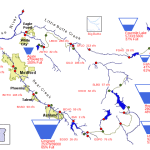Dangerous Cell Tower Approved by City: Why You Must Care and Respond to a Clear & Ever Present Danger
My comments about the AT&T cell tower approval are summarized in these notes.
In his letter to the Community Development Department on August 18, 2021 in the public record, Richard Vezie identified several valid arguments against the cell tower. Some of these also occurred to me previously, as well. To introduce this brief discussion, we provide the City’s approval criteria for a conditional use permit (AMC 18.5.4.050), which includes these statements. (Items d, e, f, and g seem most relevant.)
3. That the conditional use will have no greater adverse material effect on the livability of the impact area when compared to the development of the subject lot with the target use of the zone, pursuant with subsection 18.5.4.05.A.5, below. When evaluating the effect of the proposed use on the impact area, the following factors of livability shall be considered in relation to the target use of the zone.
a. Similarity in scale, bulk, and coverage.
b. Generation of traffic and effects on surrounding streets. Increases in pedestrian, bicycle, and mass transit use are considered beneficial regardless of capacity of facilities.
c. Architectural compatibility with the impact area.
d. Air quality, including the generation of dust, odors, or other environmental pollutants.
e. Generation of noise, light, and glare.
f. The development of adjacent properties as envisioned in the Comprehensive Plan.
g. Other factors found to be relevant by the approval authority for review of the proposed use.
Mr. Vezie is correct in his identifying cell-tower radiation as a pollutant under item d. His comment is, “EMFs are pollutants. The fact that you can’t see them does not remove that fact. These powerful signals will be ‘in the air,’ not in the form of particulates but in for the form of waves moving through our air.”
My similar argument relevant to item d is that man-made invisible pulsed electromagnetic radiation (PEMR) is more serious than dust, odors, toxic chemicals, unreasonably bright lights, and more, all of which are visible and can be avoided, managed, or removed to prevent harmful health effects. Unlike these exposures, usually of fairly short or periodic duration, the harmful health effects of PEMR, proven by thousands of scientific studies, is present 24/7. The exposure affects trees, plants, bees, animals, bacteria, and all other living things, not to mention humans.
Here are comments pertaining to item e. As an example of visible light pollution, the Ashland cell tower near Bellview School was originally equipped with an excessively bright red warning light at the top. This offended a critical number of people at night, and they were successful in having the red light replaced with one of lower intensity. As you may know, light is electromagnetic radiation (EMR) that we can see. Man-made PEMR is invisible to human eyes, but if it were visible, we would see an intolerable bright intensity of this energy in all directions from multiple sources: cell phones, cell towers, Wi-Fi, cordless phones, and more. It would then be much more “visible” that harmful effects from PEMR increase among those with greater exposure to this energy.
For item f, we can say that nationwide, public awareness of harmful effects from PEMR is increasing. Awareness among Ashland residents is already significant. Development of residential or business properties near SOU stadium will not be undertaken by people who want to avoid PEMR exposure. The Community Development Department decision paper for the SOU cell tower cites the Telecom study that reports real estate values are not affected by proximity to cell towers, but multiple real-estate studies show just the opposite with losses in property values of 15 to 20 percent. Development of properties adjacent to SOU stadium will most certainly be affected.
Item g concerns other relevant factors. One is the issue of liability insurance for the harmful health effects to be experienced by students, teachers, school employees, and city employees who work at or near SOU stadium. The Telecom industry cannot purchase liability insurance for health effects, even from Lloyds of London. They must self-insure. The City and school authorities are liable for health damages. No provision for liability insurance is included in City ordinances or State land use regulations.
Another issue is accommodation for those with Electrosensitivity in accordance with the Americans with Disabilities Act (ADA).
To eliminate PEMR exposure in public and home environments, elected officials must understand the basic solution is to implement wired broadband to each facility and/or building by using fiber optic and copper cables and a wired Ethernet. This technology uses dramatically less energy than wireless technology, is free of PEMR, offers much higher data transmission rates, and is less vulnerable to hacking. Yes, it costs more to install wired broadband, but this cost is negligible compared to the long-term costs of public health care from the adverse health effects from wireless technologies. Cell phones can be connected to the wired Internet for voice and data communications. Where needed, wireless voice and data communications can be installed inside buildings and facilities at low power levels.
Public education about harmful effects of wireless technologies is lacking in mainstream media and most people do not have discretionary time for personal research in alternative news sources, reports from advocacy groups, and scientific studies. The role of Oregon for Safer Technology is to: (1) continue efforts to educate the public and elected officials at all levels of government about the harmful effects of PEMR; and (2) work with City and County officials to develop small-cell facility ordinances to maximize their local management authority as the Telecom industry continues their rapid 5G rollout.
Alan Rathsam, Ashland
Alan is a retired mechanical engineer. In that field, he has a bachelor’s degree from Oregon State University, a master’s degree from San Diego State University, 35 years of federal civil service at a civilian U.S. Navy R&D laboratory in San Diego, CA, and a professional engineering license-retired in the State of California. He is a founding member of Oregon for Safer Technology.






